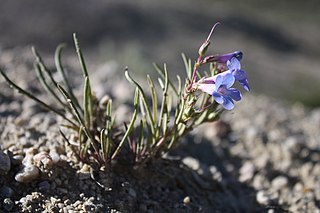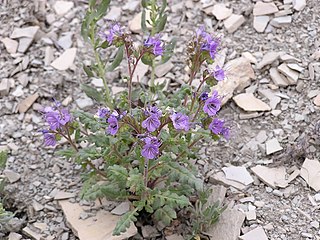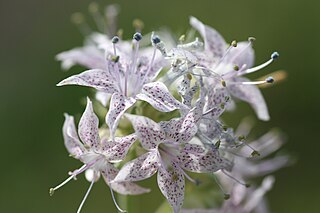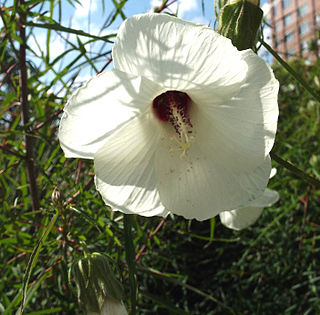
Callirhoe is a genus of flowering plants in the mallow family, Malvaceae. Its nine species are commonly known as poppy mallows and all are native to the prairies and grasslands of North America. Of the nine species, some are annuals while others are perennial plants.

Helianthus is a genus comprising about 70 species of annual and perennial flowering plants in the daisy family Asteraceae commonly known as sunflowers. Except for three South American species, the species of Helianthus are native to North America and Central America. The best-known species is the common sunflower. This and other species, notably Jerusalem artichoke, are cultivated in temperate regions and some tropical regions, as food crops for humans, cattle, and poultry, and as ornamental plants. The species H. annuus typically grows during the summer and into early fall, with the peak growth season being mid-summer.

Hibiscus moscheutos, the rose mallow, swamp rose-mallow, crimsoneyed rosemallow, or eastern rosemallow, is a species of flowering plant in the family Malvaceae. It is a cold-hardy perennial wetland plant that can grow in large colonies. The hirsute leaves are of variable morphology, but are commonly deltoidal in shape with up to three lobes. It is found in wetlands and along the riverine systems of the eastern United States from Texas to the Atlantic states, its territory extending northward to southern Ontario.

The Mauna Loa silversword, Argyroxiphium kauense, or Kaʻū silversword, is a rare species of flowering plant in the aster family. It is endemic to the eastern and southern slopes of Mauna Loa on the island of Hawaiʻi. A. kauense occurs in mountainous shrublands, bogs, and open mesic forest. The species is managed by the National Park Service and Hawaiʻi State Department of Forestry and Wildlife. It is a federally listed endangered species of the United States. There are three known populations remaining, for a total of fewer than 1000 individuals.

Sphaeralcea gierischii, Gierisch's globemallow or Gierisch mallow, is an endangered species of flowering plant in the mallow family, Malvaceae. It is native to the western United States, where it is known only from Utah and Arizona. It was described in 2002.

Argyroxiphium sandwicense subsp. sandwicense, the Mauna Kea silversword, is a highly endangered flowering plant endemic to the island of Hawaiʻi of Hawaii. It is the "crown jewel" of the volcanic mountain Mauna Kea, from which it derives its English name. The Hawaiian name is ʻahinahina; it applies to silverswords more broadly. The Mauna Kea silversword was once common on the volcano, and extraordinary conservation efforts are being made to preserve the species.

Abronia macrocarpa is a rare species of flowering plant known by the common name largefruit sand verbena. It is endemic to eastern Texas, where its current range is limited to Freestone, Leon, and Robertson counties. It inhabits harsh, open sand dunes on savannas, growing in deep, poor soils. It was first collected in 1968 and described as a new species in 1972. It is a federally listed endangered species of the United States.

Ayenia limitaris is a rare North American species of flowering plant in the mallow family known by the common names Rio Grande ayenia, Texas ayenia, and Tamaulipan kidneypetal. It is native to an area straddling the Rio Grande in Mexico and the United States. Today it is known from far southern Texas and far northern sections of the Mexican states of Coahuila and Tamaulipas. It has become rare because most of its habitat has been degraded or destroyed. There are perhaps four populations remaining in Texas and two in Mexico, for a total of 1000 individual plants at most. It is a federally listed endangered species of the United States.

Conradina verticillata is a flowering shrub in the mint family, found in the Cumberland Plateau. It is also called Conradina montana, Cumberland rosemary or Cumberland false rosemary. It has been classified as a threatened species under the Endangered Species Act since 1991.

Dicerandra frutescens is a rare species of flowering plant in the mint family known by the common names scrub mint and scrub balm. It is endemic to Highlands County, Florida, where it is known only from the Lake Wales Ridge. Its habitat is quickly being lost as it is converted to residential and agricultural use. It was federally listed as an endangered species of the United States in 1985.

Hedeoma todsenii is a rare species of flowering plant in the family Lamiaceae known by the common name Todsen's pennyroyal, or Todsen's false pennyroyal. It is endemic to New Mexico in the United States, where it occurs in the San Andres and Sacramento Mountains. It is federally listed as an endangered species of the United States.

Penstemon penlandii is a rare species of flowering plant in the plantain family known by the common names Penland penstemon and Penland's beardtongue. It is endemic to Colorado in the United States, where it is known only from a strip of land about five miles long in central Grand County. There are two occurrences totalling about 8600 individuals. This is a federally listed endangered species of the United States.

Phacelia argillacea is a rare species of flowering plant in the borage family known by the common names clay phacelia and Atwood's phacelia. It is endemic to Utah in the United States, where it is known only from one canyon in Utah County. It is "one of Utah's most endangered species"; it is "one of the nation's rarest plants" and is federally listed as an endangered species of the United States.

Sidalcea nelsoniana is a rare species of flowering plant in the mallow family known by the common names Nelson's checkerbloom and Nelson's checkermallow. It is native to the Willamette Valley and Coast Range of Oregon and the southwestern corner of Washington in the United States. It is threatened by the destruction and degradation of its habitat, and it is a federally listed threatened species of the United States.

Ipomopsis polyantha is a rare species of flowering plant in the phlox family known by the common names Pagosa ipomopsis, Pagosa skyrocket and Archuleta County standing-cypress. It is endemic to Colorado in the United States, where it occurs only in the vicinity of Pagosa Springs in Archuleta County. It is threatened by the loss of its habitat to residential and commercial development. It was federally listed as an endangered species in 2011.

Hibiscus dasycalyx is a species of hibiscus known by the common name Neches River rosemallow. It is endemic to Texas in the United States, where there are three remaining natural populations and three introduced populations.

Callirhoe involucrata is a species of flowering plant in the mallow family known by the common names purple poppy-mallow, winecup and buffalo rose. It is native to the Great Plains of the United States and adjacent areas in northern Mexico.

Croton alabamensis var. texensis is a variety of Croton alabamensis that is endemic to the state of Texas in the United States. It is commonly known as the Texabama croton.
Brickellia mosieri, the Florida brickell-bush, is a North American herbaceous plant in the family Asteraceae. It grows in Pine Rocklands in Florida, preferring low-nutrient sand close to sea level. It is characterized by small, round, rod-shaped flowers that are either brown or white. Since 1999, the total population of the Florida brickell-bush has declined by 50% due to a number of threats. Currently, it is listed as "endangered wherever found" under the ESA

Asclepias prostrata, commonly known as prostrate milkweed, is a species of perennial plant in the genus Asclepias. It has triangular to elliptical foliage with wavy margins, stems up to 16 inches (410 mm) long, and grows low to the ground in sandy soils. Flowering may be dependent on rainfall to bring the plant out of dormancy, but is most typical from April to October. Like other milkweeds, A. prostrata flowers are a food source for pollinator insects such as bees, wasps, and the Monarch butterfly.


















